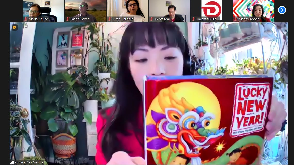February 17, 2021 - Just Networking
![]() Print this Article | Send to Colleague
Print this Article | Send to Colleague
The Toronto Chapter dedicated February as Celebration Month. Dwayne Rutherford, Connie Cay-Santos and Emilia Kim talked about diversity and traditions.
Black History Month
Dwayne shared with us some of the important facts about Black History month.

Black History month dates back to 1995, when Dr. Jean Augustine officially declared February as Black History Month in Canada.
As a Black man, he needed to be more educated on Black history, Black people’s accomplishments and how they helped to make this world a better place. He learned that in about 1500 BC, Black Egyptian people developed the sundial. Black people also invented many things that improved aspects of life, such as the traffic light, light bulb filament, elevators, refrigeration trucks, etc. If we know more about Black history and Black people’s accomplishments, we will have a more inclusive society, and Black people’s lives would be deemed more valued.
Dwayne also likes to engage his children and other youths to learn about their ancestors. In today’s world, the media portray Black people to be all the same; however, this is not true. They have different beliefs, expectations and fears.
Chinese Lunar New Year, 2021 - Year of the Ox
Connie is a Chinese Canadian. She shared with us the Lucky New Year book by Mary Man-Kong, which explained the Chinese Lunar New Year customs and rituals. A few highlights were:

There are two ways to say Happy New Year: “Kung Hee Fat Choy” (wishing someone prosperity) and “San Lin Fai Lok” (Happy New Year)
Sweeping – an act to sweep off the old and welcome the new
Oranges/Mandarin oranges – symbolize sweetness
Noodles – represent long life, the longer the better
Red envelopes – It is a tradition during Lunar New Year to visit relatives. Older generations will give younger ones red envelopes that contain money inside. More money = more luck.
Firecrackers – In ancient times, firecrackers were used to scare away evil spirits. Today, firecrackers are a notable tradition to express happiness and invite good luck.
Dragon – A Chinese dragon is a symbol of good luck. Dragon Dance is often performed during Lunar New Year; the longer the dragon is in the dance, the more luck it will bring to the community.
Celebrations – Bright colours like red, yellow, gold and orange signify colourful experiences throughout Lunar New Year.
Korean Lunar New Year - Seollal
Emilia was born in Seoul, South Korea, and she continues her traditions here in Canada in celebrating Lunar New Year (Seollal). “Sae Hae Bok Mani Badu Sayo” is Happy New Year in Korean, meaning I wish you to receive a lot of luck in the New Year.

Seollal is a three-day celebration, a time for families to catch up with each other and pay respect to ancestors. The first day of celebration begins with Charye, a memorial service that prays for the peace and good health of the ancestors. Family members will dress in hanbok, bow to greet the ancestors, followed by ritual food. After the meal, kids perform a New Year’s bow to elder family members in exchange of blessing and New Year’s money (pocket money). Families would partake in outdoor activities like flying kites, one of the traditions during Lunar New Year.
